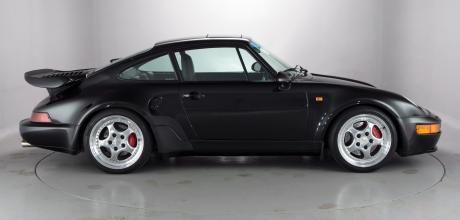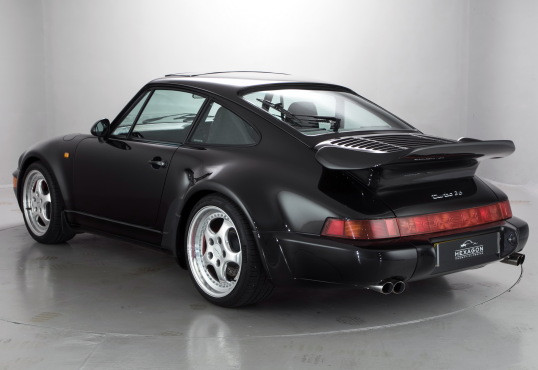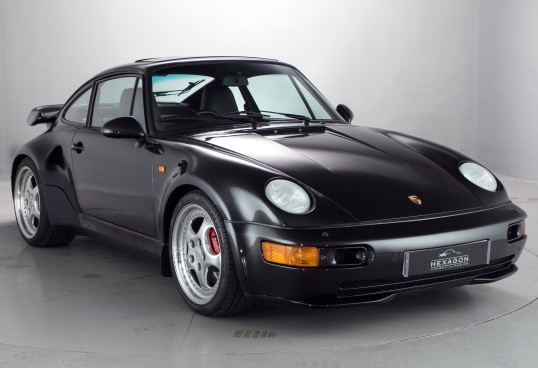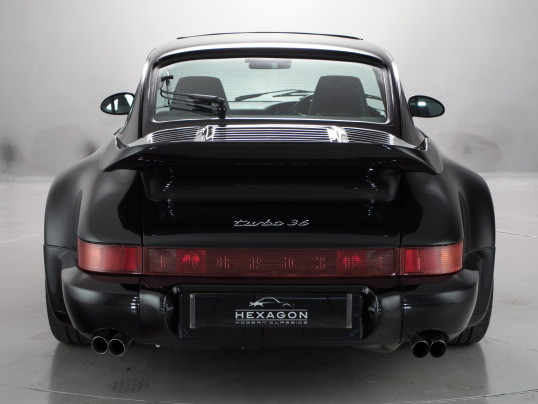Buyers’ Guide Porsche 911 Turbo 964

The 964 was the last old-school Turbo, but today it’s much-prized by collectors. Here’s your in-depth look at both the 3.3- and 3.6-litre models.
Written by Kieron Fennelly
3.3 VS 3.6: HOW TO BUY A PORSCHE 964 TURBO
Porsche Index: 964 Turbo — Kieron Fennelly unearths all the facts you need on both the 3.3- and 3.6-litre 964 Turbo
HISTORY & TECH
The 964 Turbo is famously almost the 911 Turbo that never was. Development of the new 911, the Typ 964 and its Turbo sister, the 965, were signed off in April 1984. The intention was that the 965 would be a lower-specification version of the 959.

However, difficulties with that model, not the least of which was provision of much of the new technology that Porsche was planning to incorporate, also caused delays and ultimately a de-specifying of the 965. This meant that its 4x4 transmission, air suspension and PDK transmission option would be abandoned. Yet problems with engine development remained and the absence of a new Turbo at the launch of the 964 in 1988 was noticeable and downright embarrassing when a year later and the 964 C2 appeared, there was still no 911 Turbo – the car that had become the emblem of Porsche.

Ulrich Bez took over as technical director in late 1988 and one of his first moves was to bin the unfinished 965 project. Without a Turbo, however, Porsche lost its flagship and most profitable model. 911 programme manager Fritz Bezner then went back to first principles and devised a 964 Turbo using the 930’s 3.3 Turbo S engine that sported an impressive 330hp thanks to a larger turbocharger, higher profile camshafts and modified cylinder heads and valve timing. ‘Detuned’ to 320bhp, but now with a catalytic converter, this gave a satisfactory power margin over the naturally aspirated 964’s 250hp.

Much anticipated, the new 911 Turbo was presented at Geneva in March 1990 and even if close observers realised it was something of an interim model, its refinement, handling with power steering (a first for the Turbo 911) and reassuring ABS (also new) ensured it was well received. Porsche built almost 4,000 of this ‘interim’ Turbo before the second phase, now using the 3.6-litre flat six, was launched. With only one plug per cylinder and a compression ratio of 7.5:1, the 3.6 was hardly stressed, producing 360hp and a more impressive 520Nm at 4,200rpm. The 3.6 used the by-now antique Bosch K Jetronic injection, but it was well known that a new 911 Turbo was on the way. And in the performance stakes the 3.6 wanted for very little, taking 4.8s to 100kph, 15s to 200kph and a 179.5mph top speed.

To homologate the 964 Turbo for the IMSA series in the US, Roland Kussmaul fitted a highly tuned 3.3S (380ps) in a modified 964 RS chassis. Weighing only 1,290kg (210kg less than the stock 3.3T) the S was the fastest of all the 964 Turbos: 4.7s to 100kph and 14.2s to 200kph. It won two closely fought IMSA championships (1992/93), which helped the 911’s cause Stateside.
THE VALUES STORY
The 911 964 3.3 Turbo arrived in autumn 1990, costing £74,780. Far less common than the 964 C2 or C4, it would never plumb the depreciation depths of the naturally aspirated models. Nevertheless, the plain 3.3 didn’t generate much interest for some years.
Writing in 2012, Philip Raby expressed surprise that a well-used but fit 3.3 he had took so long to sell at £25,000. He concluded that its 118,000 miles put buyers off because people were looking increasingly at the air-cooled cars as investments.
Philip was right. A decade later, it’s rare to find a 3.3 under £80,000 and such cars tend to be unoriginal or in need of work. Today, the best 3.3s sell from £150,000. The later 3.6, of which only 1,500 were built, reached its low point of around £40,000 in 2007/08, but after 2011 they started to interest collectors. Prices reached £170,000 in 2017, and kept climbing. However, post-Covid, prices now surpass £200,000. The tiny volume, though expensive S versions all were seen as investment 911s virtually from the outset (the lightweight 3.3S cost the UK buyer £128,000 new) and the 3.6S, many of which had the Flachbau nose, were nearer £180,000 fully specified. With fewer than 100 of either model, prices are often in the half-million Pound/Euro bracket.
“The advantage of the 3.6 Turbo is much-increased torque, making the sub-boost 2,000-3,000rpm range more useable”
DRIVING EXPERIENCE
The major difference between the 930 and the 964 3.3 Turbos is in steering. The 964’s assisted mechanism provides a uniformity to steering effort while the 930’s unassisted steering would, like all the G series 911s, tend to load up as the corner tightened.
Handling is generally improved over the torsion-bar sprung 930 by the 964’s independent suspension, with heavier-duty rear trailing arms and specific anti-roll bars. A new LSD, 20 per cent locking on acceleration and 100 per cent on deceleration also combats the worst of the 930’s oversteering tendencies. However, as with all the rear-drive 911 Turbos, wet roads require particular care, both in terms of throttle openings and cornering speeds.
The new short-throw gear lever is noticeably easier to use than the 930’s time-served stick, but the intermediate gearing seems high (over 80mph in second), which Porsche fitted in an attempt to offset the Turbo’s enormous thirst (15-18mpg) and apparently meet the requirements of drive-by noise tests. In practice, given the wide spacing of the ratios and the absence of torque below 3,000rpm, the Turbo can fall off boost when changing up.
In addition to a 10mph higher top speed and fractionally quicker acceleration, the advantage of the 3.6 Turbo is much-increased torque, making the sub-boost 2,000-3,000rpm range more useable. Those who have tried the rare 3.3 Turbo S on the road praise its responsiveness, though advise caution if full boost arrives midcorner. Rather like the 964 RS on which it’s largely based, the 3.3S is too harshly sprung to be driven on anything but smooth tarmac.
ABOVE Compared to the earlier 930, the 911 964 Turbo 3.3 demonstrated noticeable improvements in steering and handling
BUYERS’ GUIDE
Mike Northway of Northway Porsche observes that unlike the 964 Carrera, the Turbos are now very often collector’s items. Northway maintains several, and typically the cars materialise once a year for an MoT and oil change. Porsche’s service schedule specified intermediate attention every 12,000 miles and a major service after 24,000, but on a car travelling barely 1,000 miles per annum, maintenance is more inspection than service. As a rule, spark plugs and brake fluid are never left in situ more than four years and other consumables such as tyres, batteries and windscreen wipers are judged on age. This is the kind of service history to look for.
The 964 Turbos were a different proposition from the Carreras. Whereas plenty of these will have covered well over 200,000 miles and some will have been rebuilt, the Turbos – production of which didn’t start until late 1990 – were always destined to be low volume, especially given the 993 launch in 1993. Like any limited-edition Porsche however, they soon attracted the attention of collectors, especially the later 3.6, becoming weekend rather than commuting cars. Some did see significant use, but many will show lower mileages. However, mileometers of this generation (and previous 911s) are notoriously unreliable. A surprising number of cars will show 80 or 90,000 miles, but rarely admit to six-figure mileages. As with all 964s and earlier cars, condition is what matters.
Problems are related to lack of use, which particularly afflicts air-cooled engines where seals dry out, become porous and start leaking. Unlike the turbocharger bodies of the water-cooled 911 Turbos that rust through, the heavier design of the 964’s single blower resists corrosion, but its seals can leak oil if the car lies unused for long periods. On the other hand, the bigger Turbo brakes don’t seize in their calipers as the stock 964’s tend to. Expect to find the air-conditioning functioning properly – neglect here begs the question of what else the owner has failed to repair. Sunroofs can jam (usually a cable has failed) or leak, and beware the slightest smell of damp in the cabin. Unless panels have at some point been replaced incompetently, neither the 964T’s body nor its chassis should show any sign of corrosion.
The Cup-look wheels of the 3.3 are more easily maintained than the 3.6s’s three-piece Speedline rims, which are prone to deterioration.
On a purchase running well into six figures, a buyer might expect all to be in perfect order, but especially for a 3.6T this isn’t a given. All equipment as well as the service history needs to be checked, and in the case of restored cars, who the restorer was, details of work carried out together with evidence of use of original equipment. Any less than original cars or examples that have been tuned (other than factory-fitted power kits), shod with the ‘wrong’ wheels or other customisation are severely marked down by the fastidious collector market.
ABOVE When looking to purchase a 964 Turbo, you’ll need to inspect the car inside and out. A smell of damp inside the cabin doesn’t bode well, while air-conditioning that fails to function properly is a sign that general maintenance has been neglected.
DESIRABLE OPTIONS
Porsche always fitted the Turbos out fully and charged a handsome price. Originality is important though, and items like the sound system need to be period-correct. For example, a Bluetooth upgrade should be suitably disguised. For customers who wanted more power, Porsche Exclusive offered the X88 kit for both models: a larger turbocharger, revised valve timing and reworked heads and manifolds increased power to 355hp for the 3.3 and to 385hp for the 3.6. These were rare cars and in the case of the 3.6, often combined with the Flachbau nose, but these models tend to be far into the £200,000-plus collectorsphere. It’s important to check that these are genuine Exclusive-assembled cars and not aftermarket productions, which are worth significantly less.
INVESTMENT POTENTIAL
As ever, the best investments will be the most original cars that come with verifiable service histories. Colour combination such as black coachwork and black interiors add value, as do rare special shades like Venetian or Satin blue metallic with matching leather.
The period since 2020 has demonstrated that the value of the 3.6 Turbo is moving in line with the other low-volume, air-cooled 911s. The really low-mileage examples, especially those with the X88 kit (of which only 13 were RHD) combined with famous provenance will be worth far more. Jonathan Leach of Cridfords has suggested that at stratospheric price levels, when a particularly rare 911 might be the only one on the market, a rich collector may pay a world-record amount on a whim.
As it stands in mid-2023, the buyer who chooses wisely is unlikely to lose money on a 964 Turbo, and the decision depends on whether they’re looking at the 964 Turbo as an ISA or an iconic sports car. Investments, as we’re constantly being reminded, can go up or down, but air-cooled 911 Turbos have all being going in one direction for the best part of two decades. Promising, but as ever, caveat emptor!
TOP RIGHT The 964 Turbo 3.6 had an upgraded, lower suspension, bigger brakes, plus iconic ‘Speedline’ split rims
TOTAL 911 VERDICT
The 964 is a landmark 911, the last one to be built before the cost accountants and work-study engineers alighted upon Porsche’s predilection for over-engineering everything. The final rear-drive and single turbo 911s were by some margin the best yet. Weissach enhanced the Turbo’s driveability, especially on the 3.6, and if they lacked the sophistication and better mpg that Motronic management would have conferred, Porsche’s Turbos still went like hell – even if their unfashionably high emissions and low mpg meant production life would be short. For those seeking a boulevard ride, there was always the admirable Lexus: Porsche’s old-school turbos were really of the “because we still can” variety, an appropriately two-finger gesture to creeping conformity.
Today, a majority – especially the 3.6s – have become investments. This is a pity. The 964 Turbo is a practical, classic 911. It’s non-temperamental in traffic, a good touring option, easy enough to drive fast, but above all offers a real challenge to the skilled 911 exponent capable of getting the best from what is an entirely analogue sports car. The once-extrovert spoiler and wings still attract attention, but because the air-cooled 911 looks so small compared with modern supercars and its frog eyes are such a classic old-Porsche feature, the 964 Turbo is more likely to generate smiles than snarls.
ABOVE A single KKK turbocharger was fitted to the 3.3-litre engine of the 964, helping it to develop 330hp.
ABOVE The distinctive teatray wing of the 964 housed a single intercooler
MARKET RIVALS
Focusing on the 911 3.3-litre Turbo here, a current online search finds a values range of between £130,000 and £180,000. This opens the door to a variety of 911 alternatives both old and new…
- 964 RS - More usable power and predictable handing than the 964 Turbo, the 964 RS can’t match the cruising speed refinement of the Turbo (between £160,000 and £220,000), but its RS badge ensures it remains a worthy investment piece.
- 911 2.4 S - Its longer stroke and torquier engine makes this arguably the most desirable of the long-bonnet S 911s. Light, agile and perfect for summer Sunday mornings when the roads are quiet, a good car will set you back £180,000.
- 991.2 GT3 - It might lack a turbocharger, but as a ‘high days and holidays’ 911, it gives plenty of theatre, although it’s most at risk of depreciation of the four models mentioned here. Currently yours for around £140,000.
- 993 Turbo - £150,000 should net a blown 993 of good provenance. Discreet, eminently useable, hard wearing and the ultimate air-cooled 911, it’ll serve you better on a European roadtrip than a 964 Turbo, though it might not be as fun on a Sunday drive.

